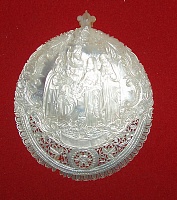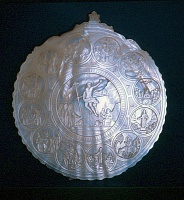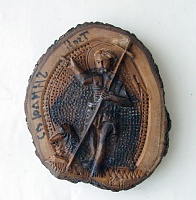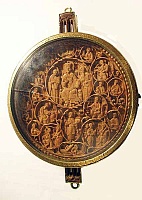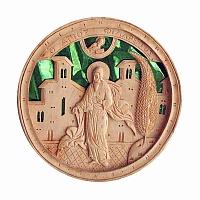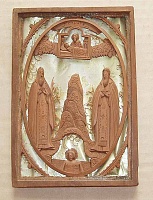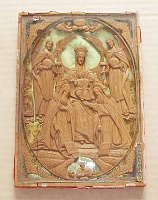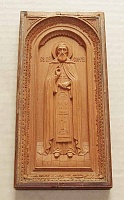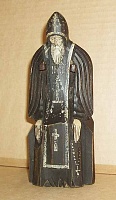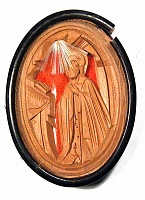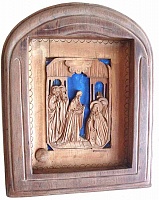Small-Size Works of the 18th – Early 19th Centuries
In the 18th – early 20th centuries miniatures of bone, mother-of-pearl and different specious of wood and stone were mainly eulogia, mementos brought by Christians from holy places. They were mass-produced for pilgrims of different means. Usually they were of neither material no artistic value. Those mementos of long pilgrimage were kept in the icon-cases and passes from generation to generation. Some of them had inscriptions like “ Blessing from the Holy Sepulcher for devotional and good memory…”
T he collection of the Sergiev Posad Museum-Preserve includes carved icons and crosses, “representing” a lot of Orthodox centers: Palestine, Athos, the Kiev Lavra of the Caves and the Trinity-St. Sergius Lavra, the Solovetsky Monastery, St. Nil Hermitage. The major Palestine centers of pilgrimage and souvenir production are Jerusalem and Bethlehem. From these cities are numerous fine mother-of-pearl icons and crosses in the Museum collection. The group of icons depicting Adoration of the Shepherds, adoration of the Magi and the Nativity of Christ are connected with Bethlehem. The Jerusalem variant of the subject is levitating Christ with the Ascension Cathedral in the background, that is a combination of the event and the monument glorifying it. The icon with the image of St. John the Baptist, also brought from the Holy Land, is quite primitively carved in the wood cross section.
The most interesting samples in the collection are the panagia with the carved coral images of Savior in a crown of thorns and the praying Virgin, pectoral cross and panagia made of mother-of-pearl for church services of Moscow Metropolitan Filaret (Drozdov) in the Assumption Gethsemane priory, wooden church service cross with lace-like carving of the 18th century which used to belong to Moscow Metropolitan Platon (Levshin).
The Athos works with intricate miniature carving depicting holy images were highly appreciated all over the Orthodox world. The Museum collection includes several panagias and crosses with inscriptions in Greek. One of the double-sided icons was probably presented to Moscow Metropolitan Filaret (Drozdov)
«I“f you cannot afford to visit Jerusalem, welcome to the Russian Holy Town!” – wrote A.N. Muravjev from Kiev to Bishop Leonid (Krasnopevky) of Dmitrov in 1869. Numerous and diverse eulogia from the Kiev Lavra of the Caves “introduced” a wide range of saints and relics of Kiev. Crosses and icons of different size depict the Lavra founders – SS. Antony and Feodosy of the Caves, St. Barbara, Archangel Michael and worshipped icons – the Virgin of the Caves and the Assumption.
Since the late 1820s pilgrims were blessed with small icons and crosses carved in cypress in the Trinity-St. Sergius Lavra. Carvings were supplied by the inhabitants of the surrounding villages. The most famous craftsmen were the Tsyrulnikovs and Khrystachevs. The favorite themes were images of SS Sergius and Nikon of Radonezh and the scene “The Appearance of the Virgin to St. Sergius of Radonezh”. By the early 20th century the range of subjects had considerably widened. The Museum collection includes miniature icons with the images of the Virgin of Iberia, Guardian Angel, St. Ioasaf of Belgorod, etc. Objects with inscriptions are most valuable. The inscription on one of icons runs that its price was one rouble and that it was bought by ” E. Yakov in the Trinity-St. Sergius Lavra on Sunday in September 7, 1869”.
Unfortunately there are no woodworks with authors’ signatures in the Museum collection. The miniature icons are presumably ascribed to this or that craftsman. Nevertheless, we are quite sure that we have works of the most famous carvers of Sergiev Posad: Ivan Semyonovich Khrustachev and his sons – Konstantin and Vladimir. The Crucifixion with Interceding Saints (“The Golgotha”), carved in cypress and covered by a glass dome, is associated with I.A. Tsyrulnikov. Palestine, Athos, the Kiev Lavra of Caves and the Trinity-St. Sergius Lavra are represented by groups of varied works, but there is only one work of the Solovetsky Monastery. There are several sculptural figures of Nil Stolobensky , but they are of the same type. Such figures were produced in the surroundings of St. Nil Hermitage.
The ivory icon “The Trinity” and folding icon “St. Sergius and Scenes from His Life”, carved by the Trinity novice Ivan Ilyin (monk Iona) in 1866, are unique works of that time. They are rare commissioned samples of miniature works. The folding icon was presented at the World Exhibition in Paris and returned with “ an honorable reference ”.
The collection of the 18th – 19th century miniature works in the Sergiev Posad Museum includes memorial items, as well as, “utilitarian” products like various crosses and pectoral panagias. Some Gospels and liturgical vessels are decorated with plaques with relief holy images carved in wood, mother-of- pearl or bone. A lot of objects are supplemented with precious mountings and inserted decorations. Many works are inimitable. Practically all of them are made by the best Russian craftsmen.









